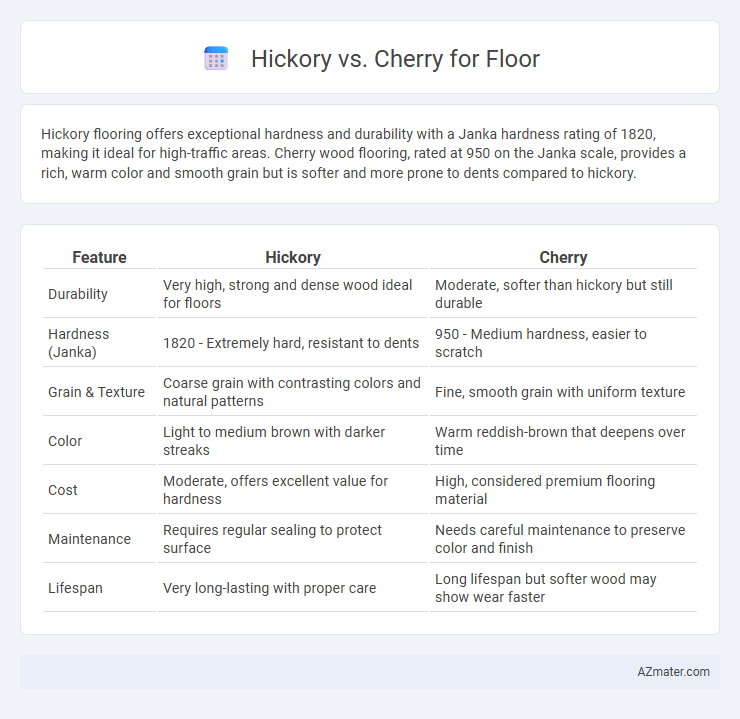Hickory flooring offers exceptional hardness and durability with a Janka hardness rating of 1820, making it ideal for high-traffic areas. Cherry wood flooring, rated at 950 on the Janka scale, provides a rich, warm color and smooth grain but is softer and more prone to dents compared to hickory.
Table of Comparison
| Feature | Hickory | Cherry |
|---|---|---|
| Durability | Very high, strong and dense wood ideal for floors | Moderate, softer than hickory but still durable |
| Hardness (Janka) | 1820 - Extremely hard, resistant to dents | 950 - Medium hardness, easier to scratch |
| Grain & Texture | Coarse grain with contrasting colors and natural patterns | Fine, smooth grain with uniform texture |
| Color | Light to medium brown with darker streaks | Warm reddish-brown that deepens over time |
| Cost | Moderate, offers excellent value for hardness | High, considered premium flooring material |
| Maintenance | Requires regular sealing to protect surface | Needs careful maintenance to preserve color and finish |
| Lifespan | Very long-lasting with proper care | Long lifespan but softer wood may show wear faster |
Introduction to Hickory and Cherry Flooring
Hickory flooring offers exceptional hardness and durability, making it ideal for high-traffic areas, with a natural grain pattern that adds rustic charm to any space. Cherry flooring provides a smooth texture and rich, warm tones that deepen over time, enhancing elegance and sophistication in residential interiors. Both hardwood options bring distinct aesthetics and performance qualities, catering to diverse design preferences and durability needs.
Appearance and Grain Patterns
Hickory flooring features a bold, rustic appearance with dramatic color variations ranging from creamy whites to rich browns, showcasing prominent, swirling grain patterns that add a dynamic texture to any space. Cherry wood offers a smoother, more uniform grain with fine, straight patterns and a warm reddish-brown hue that deepens elegantly over time, creating a sophisticated and classic look. Both woods provide distinct aesthetic qualities, with hickory drawing attention through its rugged, varied grain and cherry appealing for its subtle consistency and rich, evolving coloration.
Color Variations and Aging
Hickory flooring offers a wide range of color variations from creamy white to rich reddish-brown, displaying a natural, rustic character that deepens over time. Cherry wood floors start with a uniform light pinkish tone that darkens to a deep reddish-brown, gaining warmth and richness as it ages. Both woods develop a unique patina, but cherry's color transformation is more pronounced and typically enhances the elegance of interior spaces.
Durability and Hardness Comparison
Hickory flooring ranks among the hardest domestic woods with a Janka hardness rating of 1,820, making it extremely durable and resistant to wear, ideal for high-traffic areas. Cherry wood, with a Janka rating of 950, is significantly softer, offering moderate durability better suited for low-traffic spaces. The superior hardness of Hickory provides enhanced resistance to dents and scratches, whereas Cherry floors develop a rich patina over time, adding character but requiring more care to maintain.
Maintenance and Care Requirements
Hickory flooring requires regular sweeping and occasional damp mopping to prevent dirt buildup, with periodic refinishing every 7-10 years to maintain its durability and appearance. Cherry floors demand gentle cleaning methods, using a soft broom or vacuum with a floor-brush attachment, and should avoid excessive moisture to preserve their softer wood texture and rich patina. Both wood types benefit from furniture pads and humidity control to minimize scratches and warping, ensuring long-lasting beauty with proper maintenance.
Cost Differences and Budget Considerations
Hickory flooring typically costs between $5 to $8 per square foot, offering a more budget-friendly option compared to cherry wood, which ranges from $7 to $12 per square foot due to its rarity and rich coloration. Hickory's durability and affordability make it ideal for homeowners seeking cost-effective yet resilient flooring, while cherry's premium price reflects its luxurious appearance and fine grain patterns. Budget considerations should also factor in maintenance and long-term wear, as cherry may require more careful upkeep to preserve its natural luster.
Installation Process and Compatibility
Hickory flooring offers a denser, harder surface that requires precise acclimation and moisture control during installation, making it ideal for high-traffic areas. Cherry wood, softer and more dimensionally stable, allows easier cutting and nailing, providing flexibility in both nail-down and floating installations. Both woods are compatible with various subfloor types, but hickory demands stricter moisture barriers to prevent cupping, while cherry adapts better to moderate humidity changes.
Environmental Impact and Sustainability
Hickory flooring is generally sourced from fast-growing forests, making it a more sustainable choice due to quicker regeneration rates and lower environmental strain. Cherry wood, often harvested from slower-growing trees, can have a higher environmental impact due to longer growth cycles and increased deforestation risks. Both materials can be environmentally responsible when certified by organizations like FSC, but hickory's rapid renewability typically offers a smaller carbon footprint in flooring applications.
Popular Applications and Design Styles
Hickory flooring is widely favored in rustic and country-style interiors due to its durability and distinctive grain patterns, making it ideal for high-traffic areas and cabins. Cherry wood is popular in traditional and formal design styles, offering a rich, warm reddish tone that deepens with age, perfect for living rooms and dining spaces. Both woods complement a variety of decor themes, but hickory suits casual, farmhouse aesthetics while cherry elevates classic and elegant environments.
Choosing the Right Wood for Your Home
Hickory offers exceptional hardness and durability, making it ideal for high-traffic areas and homes with active families, while cherry wood provides a rich, warm tone that deepens with age, perfect for creating a cozy, elegant ambiance. Hickory's distinctive grain patterns and resistance to dents suit rustic or traditional decor, whereas cherry's smooth texture and fine grain complement classic and contemporary styles. Selecting between hickory and cherry for flooring depends on balancing desired aesthetics, durability requirements, and maintenance levels to match your home's lifestyle and interior design.

Infographic: Hickory vs Cherry for Floor
 azmater.com
azmater.com